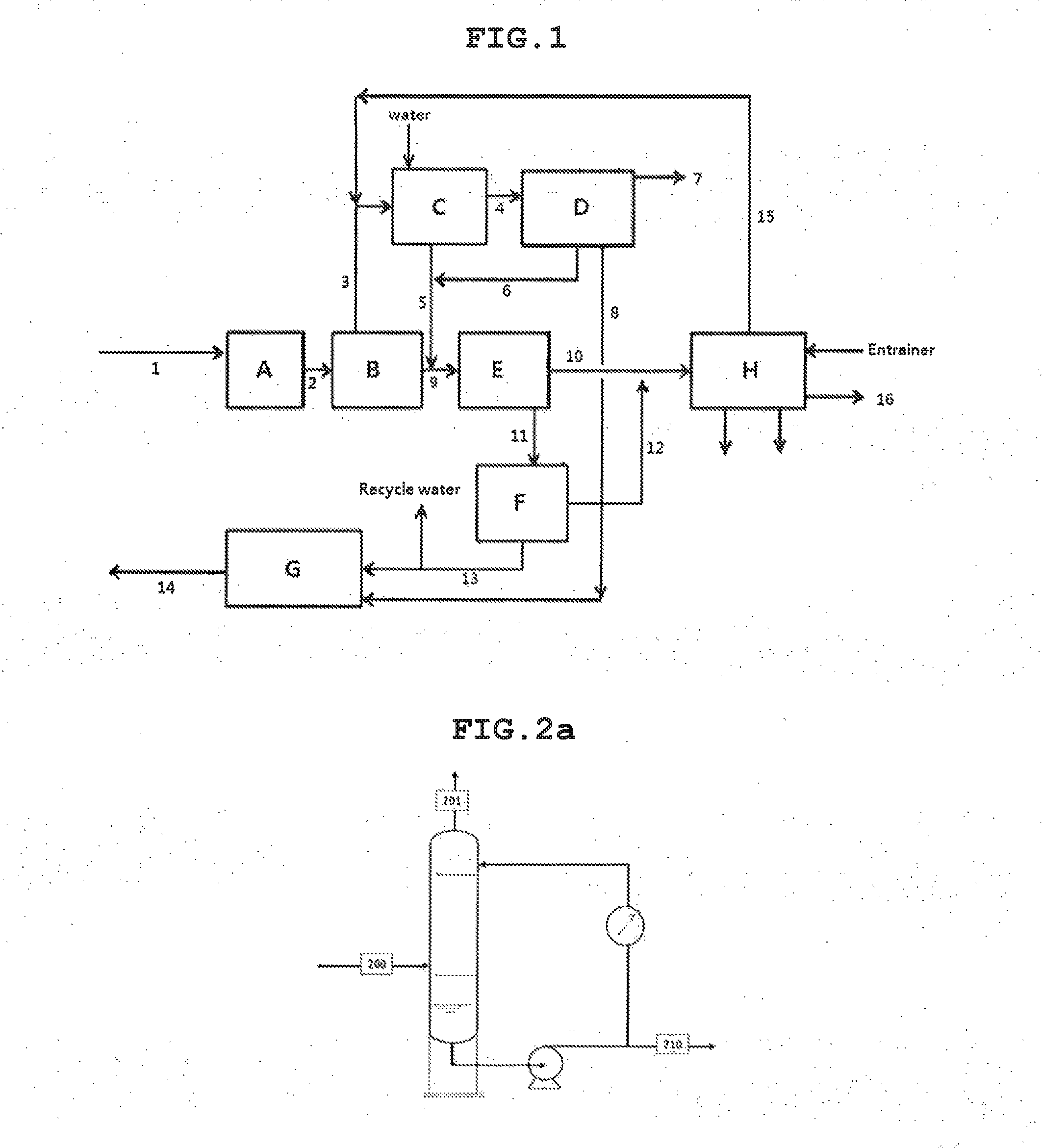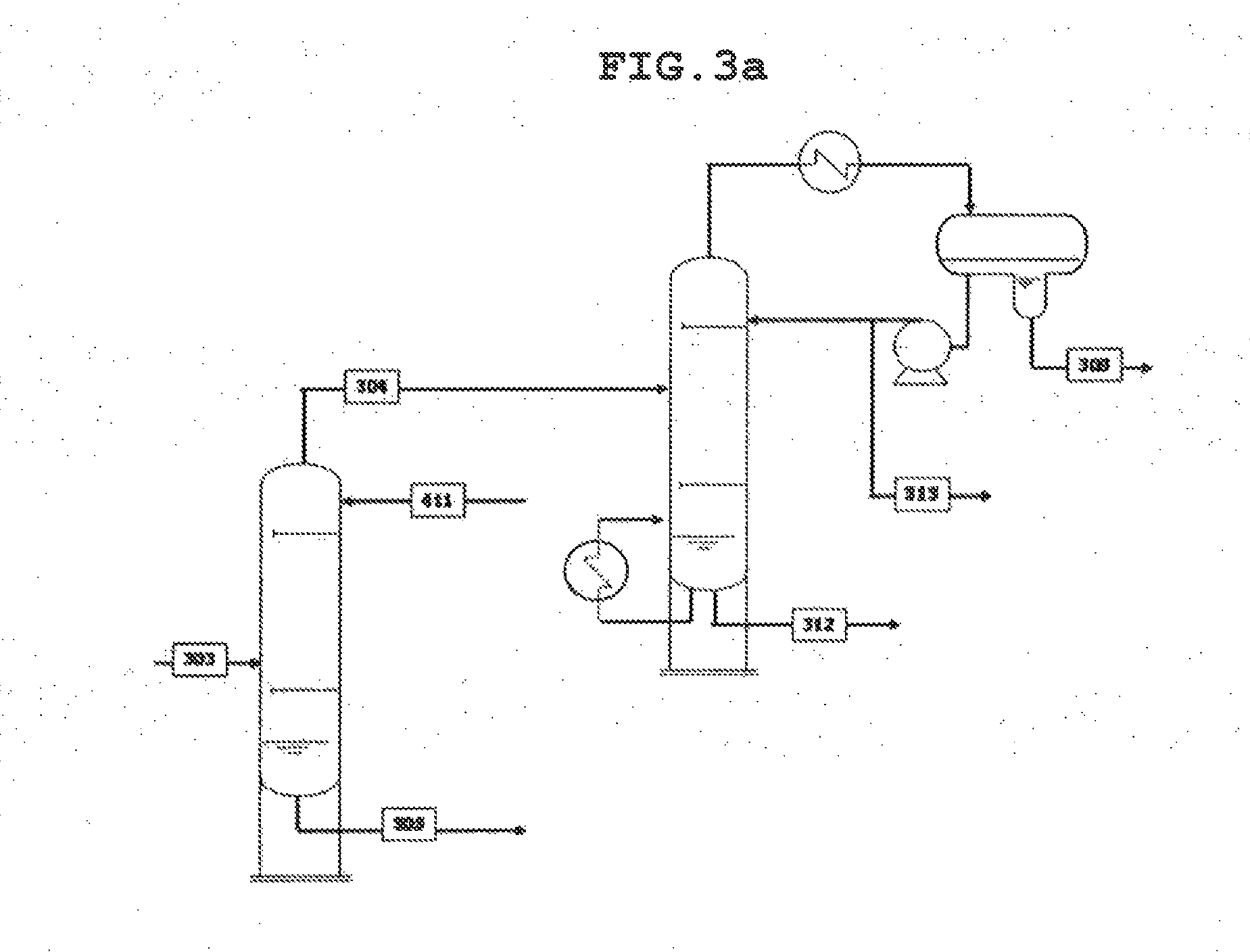Method of recovering 1,3-butadiene and methylethylketone from dehydration products of 2,3-butanediol
a technology of methylethylketone and dehydration products, which is applied in the direction of fractional condensation purification/separation, waste based fuel, and separation processes. it can solve the problems of limited resource availability, environmental pollution, and uneven product cost, and achieve the effect of reducing the number of dehydration products
- Summary
- Abstract
- Description
- Claims
- Application Information
AI Technical Summary
Benefits of technology
Problems solved by technology
Method used
Image
Examples
example 1
[0165]As illustrated in the process of FIG. 1 and the details of FIGS. 2A, 3A, 4A, 6A, 7A and 8A, recovery of highly pure 1,3-butadiene and methylethylketone from the dehydration products of 2,3-butanediol was simulated using ASPEN PLUS. The process simulation was based on 100,000 tons of 2,3-butanediol feed per year.
[0166]The dehydration of 2,3-butanediol was carried out using an amorphous calcium phosphate catalyst (Ca / P molar ratio: 1.2) under the conditions shown in Table 5 below.
TABLE 5Space velocityReaction Temp.Reaction Pressure(WHSV)Conversion360° C.Atmospheric pressure0.5 hr−1100%
TABLE 6QuencherScrubber1,3-BD fractionatorPressure (O / H) [kg / cm2g]0.83.93.2Temp. (O / H) [° C.]523938Temp. (BTM) [° C.]8060136Theoretical stage number5530Reflux ratio2.3
TABLE 71,3-BDpurificationEDC1st Stripper2nd StrippercolumnPressure (O / H)5.53.90.53.7[kg / cm2g]Temp. (O / H) [° C.]58434240Temp. (BTM) [° C.]11212013044Theoretical stage3615155numberReflux ratio5.32.30.22Organic phasetotal reflux
TABLE 8Wa...
example 2
[0179]The process simulation was carried out in the same manner as in Example 1, with the exception that the simple distillation column and the 1,3-BD recovery column shown in FIG. 5A were used, in lieu of the process performed in the sequence of the extractive distillation column, first and second strippers and 1,3-BD purification column of Example 1. The separation conditions of the distillation column and the 1,3-BD recovery column are shown in Table 9 below.
TABLE 9Distillation column1,3-BD recovery columnPressure (O / H) [kg / cm2g]3.83.5Temp. (O / H) [° C.]4241Temp. (BTM) [° C.]4444Theoretical stage number8056Reflux ratio1112.2
[0180]As illustrated in FIG. 5A, the stream 316-1 derived from the overhead stream of the 1,3-BD fractionator was fed to the distillation column, and the overhead stream comprising water and a mixture of 1,3-BD and 1-butene was separated. Furthermore, the mixture of 1,3-BD and 1-butene was separated as a C4 mixture from the above overhead stream using the heat ...
example 3
[0183]In the dehydration of 2,3-butanediol as illustrated in FIG. 2A, a pilot test was performed to evaluate the actual performance of the reactor. The process conditions of the reactor for use in the pilot test are shown in Table 10 below.
TABLE 10ReactorKind and dimensionFixed-bed reactorof reactorDiameter: 3 cm, Height: 1.3 mCatalystKind: Amorphous calcium phosphate catalyst(Ca / P molar ratio: 1.2)Diameter: 2.85 mm, Weight: 80 gCatalyst loading: loading in a space between 0.6 mfrom the top of the reactor and 0.3 m from thebottom thereof.(SiC is packed in a space ranging from the top of thereactor to 0.6 m and a space ranging from thebottom of the reactor to 0.3 m)Feed98.65 wt % of 2,3-butanediolProcess conditionsPressure: 0.2 barAverage temperature of catalyst bed: 348° C.WHSV: 0.5 h−1
[0184]The details of the inflow and outflow streams of the reactor are shown in Table 11 below. The performance of the reactor depending on the inflow and outflow streams of the reactor is given in Ta...
PUM
| Property | Measurement | Unit |
|---|---|---|
| wt % | aaaaa | aaaaa |
| wt % | aaaaa | aaaaa |
| wt % | aaaaa | aaaaa |
Abstract
Description
Claims
Application Information
 Login to View More
Login to View More - R&D
- Intellectual Property
- Life Sciences
- Materials
- Tech Scout
- Unparalleled Data Quality
- Higher Quality Content
- 60% Fewer Hallucinations
Browse by: Latest US Patents, China's latest patents, Technical Efficacy Thesaurus, Application Domain, Technology Topic, Popular Technical Reports.
© 2025 PatSnap. All rights reserved.Legal|Privacy policy|Modern Slavery Act Transparency Statement|Sitemap|About US| Contact US: help@patsnap.com



